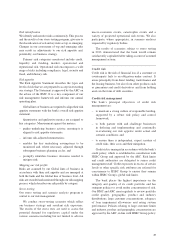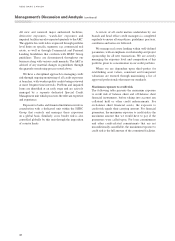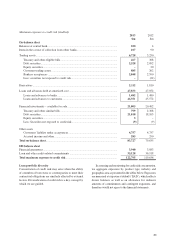HSBC 2013 Annual Report Download - page 43
Download and view the complete annual report
Please find page 43 of the 2013 HSBC annual report below. You can navigate through the pages in the report by either clicking on the pages listed below, or by using the keyword search tool below to find specific information within the annual report.
41
Exposures to core and peripheral eurozone countries (Audited)
2013 2012
Financial
institutions
$m
1Sovereign
$m
Total
$m
Financial
institutions
$m
1Sovereign
$m Total
$m
Core countries
Germany ...................... 326 205 531 326 – 326
France .......................... 215 258 473 316 156 472
Total core countries ........ 541 463 1,004 642 156 798
Peripheral countries
Greece .......................... 3–3 – – –
Italy .............................. 60 – 60 12 – 12
Portugal ....................... 6 – 6 1 – 1
Spain ............................ 86 – 86 8–8
Total peripheral
countries ...................... 155 – 155 21 – 21
Total ............................... 696 463 1,159 663 156 819
1 Exposures with financial institutions include exposures with other HSBC Group affiliates of $3m in Germany, $29m in France, $64m in
Spain and $3m in Greece (31 December 2012: $3m in Germany, $8m in France and $7m in Spain).
Liquidity and funding risk
Liquidity risk is the risk that the bank does not have
sufficient financial resources to meet its obligations as they
fall due, or will have to do so at an excessive cost. This risk
arises from mismatches in the timing of cash flows.
Liquidity and funding risk management
The objective of our liquidity and funding management
strategy is to ensure that all foreseeable funding
commitments, including deposit withdrawals, can be
met when due, and that access to the wholesale markets
is coordinated and cost-effective.
The ARC is responsible for defining the bank’s
liquidity risk tolerances within the HSBC Group’s
liquidity risk framework, which mandates that each site
manages its liquidity and funding on a self-sustaining
basis. The ARC also reviews and approves the bank’s
liquidity and funding policy and is responsible for its
oversight.
The bank’s Asset and Liability Committee (‘ALCO’)
is responsible for the development of policies and
practices to manage liquidity and funding risk. Its
mandate is established by HSBC Group policy, the
ARC, and the bank’s RMC.
ALCO is responsible for the oversight of liquidity
and funding risk management, establishing liquidity
risk parameters, and monitoring metrics against risk
appetite, funding costs, and early warning indicators of
a liquidity stress. ALCO is also responsible for ensuring
the operational effectiveness of the bank’s liquidity
contingency plan.
The management of liquidity and funding is
carried out by our Balance Sheet Management group
in accordance with practices and limits approved by
ALCO, the ARC and HSBC Group. Compliance with
policies is monitored by ALCO.
The objective of our liquidity framework is to allow
us to withstand very severe liquidity stresses. It is
designed to be adaptable to changing business models,
markets and regulations.
Our liquidity and funding risk management
framework requires:
– liquidity to be managed on a stand-alone basis with
no implicit reliance on the HSBC Group or central
banks;
– compliance with the limit for the advances to core
funding ratio; and
– maintaining cumulative positive cash flows in
each time band within the specified time horizons
in respect of idiosyncratic and market-wide stress
scenarios, respectively.
41
























